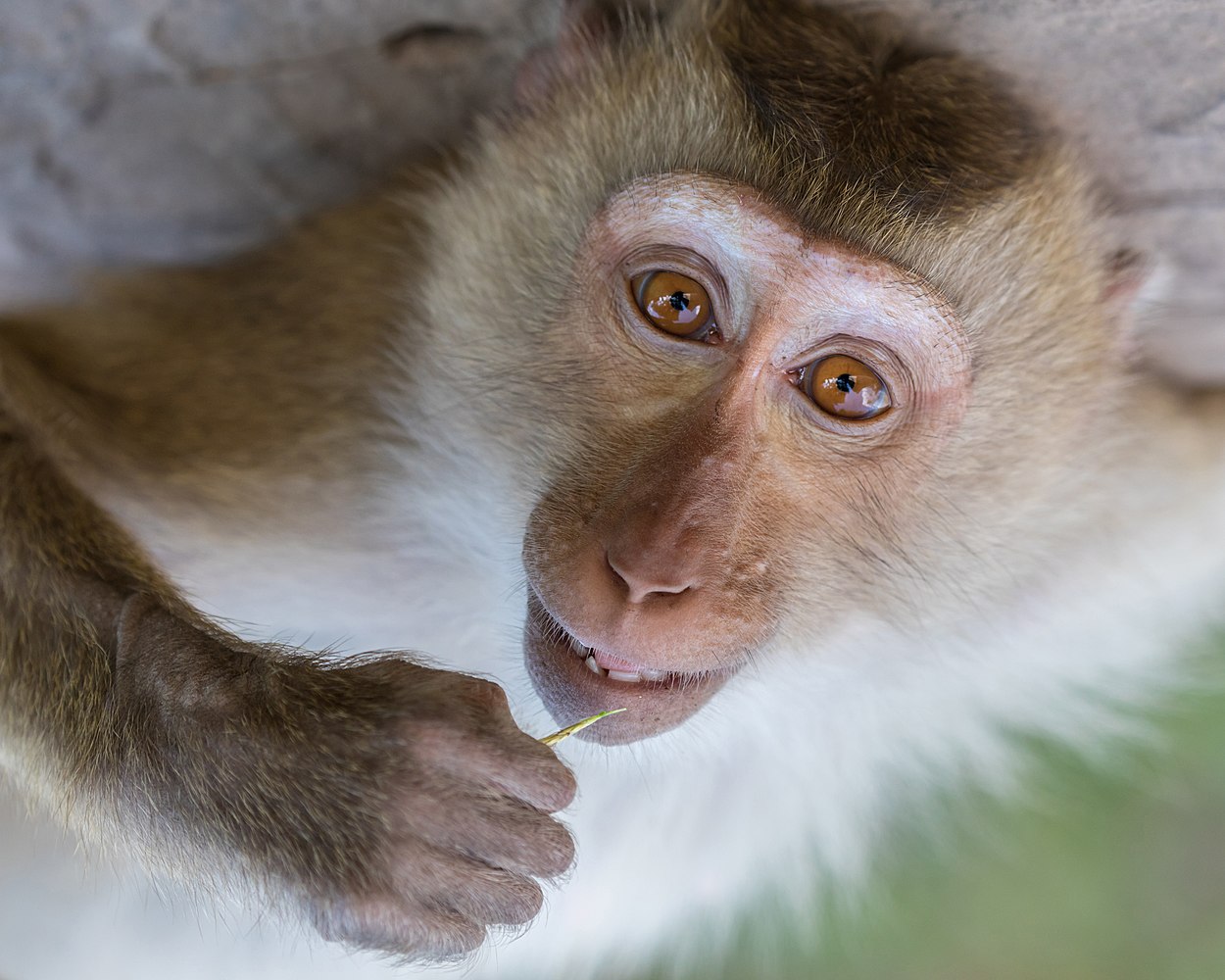
![]() Enlarge
Enlarge
Macaca fascicularis (crab-eating macaque) lying on its back and putting to its mouth a plant stem, the eyes wide open looking at the viewer, at the temple of Don Som (Si Phan Don), Laos.
6 December 2018, 15:47
 This picture has been published in the website of the Fondation Brigitte Bardot: "The Surviving Macaques Of Labenne Join The Refuge Of La Tanière", in 2019,
This picture has been published in the website of the Fondation Brigitte Bardot: "The Surviving Macaques Of Labenne Join The Refuge Of La Tanière", in 2019,
and in Ciencianarua: "Primeiro embrião com células de macacos e humanos pode ajudar pesquisas sobre doenças que nos afligem", in 2021.
 This picture is available on Wikimedia Commons with a free license CC BY-SA 4.0 (Attribution-ShareAlike 4.0 International) - © Basile Morin
This picture is available on Wikimedia Commons with a free license CC BY-SA 4.0 (Attribution-ShareAlike 4.0 International) - © Basile Morin
_on_a_human_finger_at_golden_hour.jpg)
![]() Enlarge
Enlarge
Plexippus petersi (jumping spider), male, on a human finger, at golden hour in Don Det, Si Phan Don, Laos. Appromimately 7 mm (0.28 in) diameter legs included. Focus stacking from 9 pictures, handheld camera with macro lens.
12 February 2019, 16:22
 This photograph was a finalist in Picture of the Year 2019 international challenge on Wikimedia Commons.
This photograph was a finalist in Picture of the Year 2019 international challenge on Wikimedia Commons.
 This picture is available on Wikimedia Commons with a free license CC BY-SA 4.0 (Attribution-ShareAlike 4.0 International) - © Basile Morin
This picture is available on Wikimedia Commons with a free license CC BY-SA 4.0 (Attribution-ShareAlike 4.0 International) - © Basile Morin
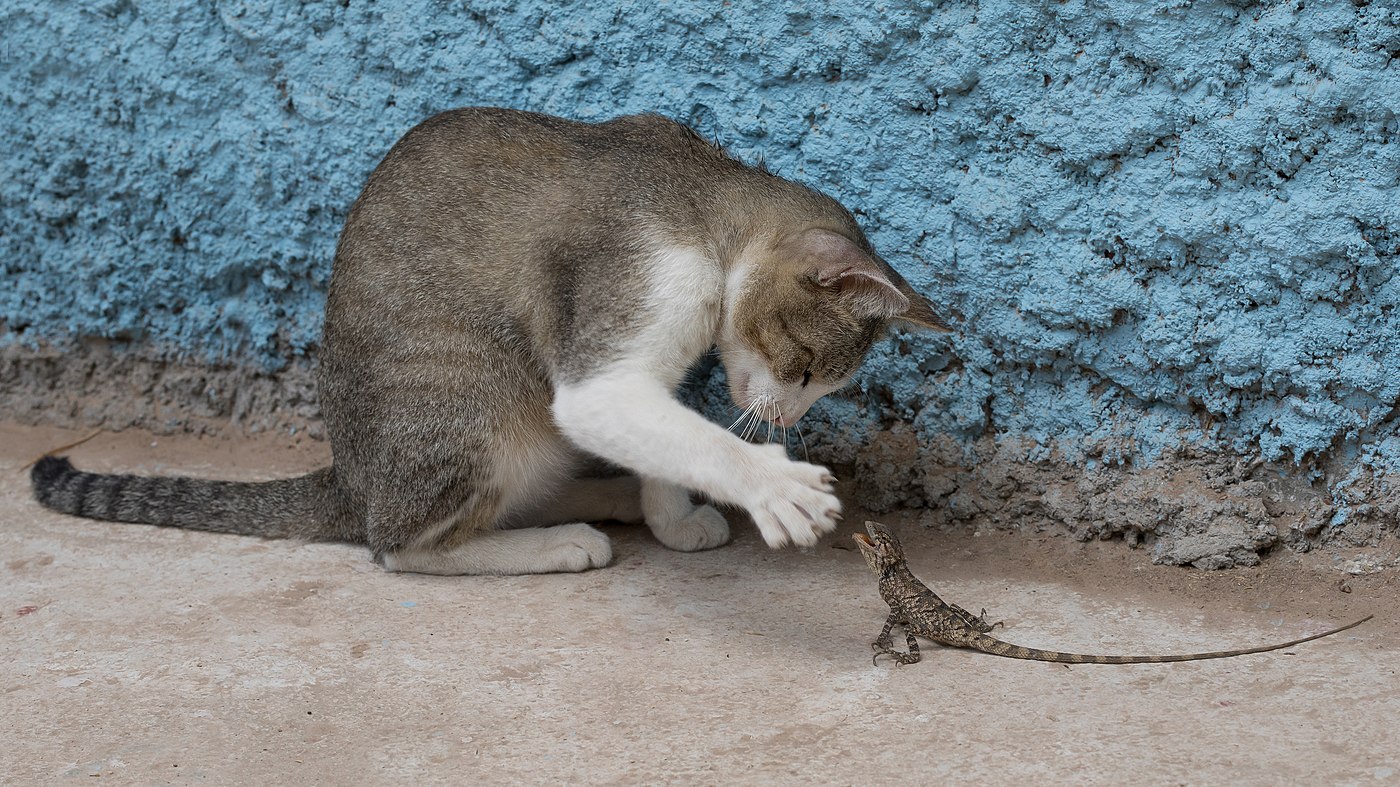
![]() Enlarge
Enlarge
Seated Felis silvestris catus (domestic cat) playing with a passive Calotes versicolor (oriental garden lizard), facing it, in Laos.
26 April 2018, 12:19
 This photograph won the 6th position as a finalist in Picture of the Year 2018 international challenge on Wikimedia Commons.
This photograph won the 6th position as a finalist in Picture of the Year 2018 international challenge on Wikimedia Commons.
Other versions exist: version 2, version 3, version 4, version 5, and a short video.
 This picture is available on Wikimedia Commons with a free license CC BY-SA 4.0 (Attribution-ShareAlike 4.0 International) - © Basile Morin
This picture is available on Wikimedia Commons with a free license CC BY-SA 4.0 (Attribution-ShareAlike 4.0 International) - © Basile Morin
_eating_a_frog.jpg)
![]() Enlarge
Enlarge
Eutropis macularia (bronze grass skink) eating a frog, in Laos.
11 January 2018, 13:09
 This picture is available on Wikimedia Commons with a free license CC BY-SA 4.0 (Attribution-ShareAlike 4.0 International) - © Basile Morin
This picture is available on Wikimedia Commons with a free license CC BY-SA 4.0 (Attribution-ShareAlike 4.0 International) - © Basile Morin
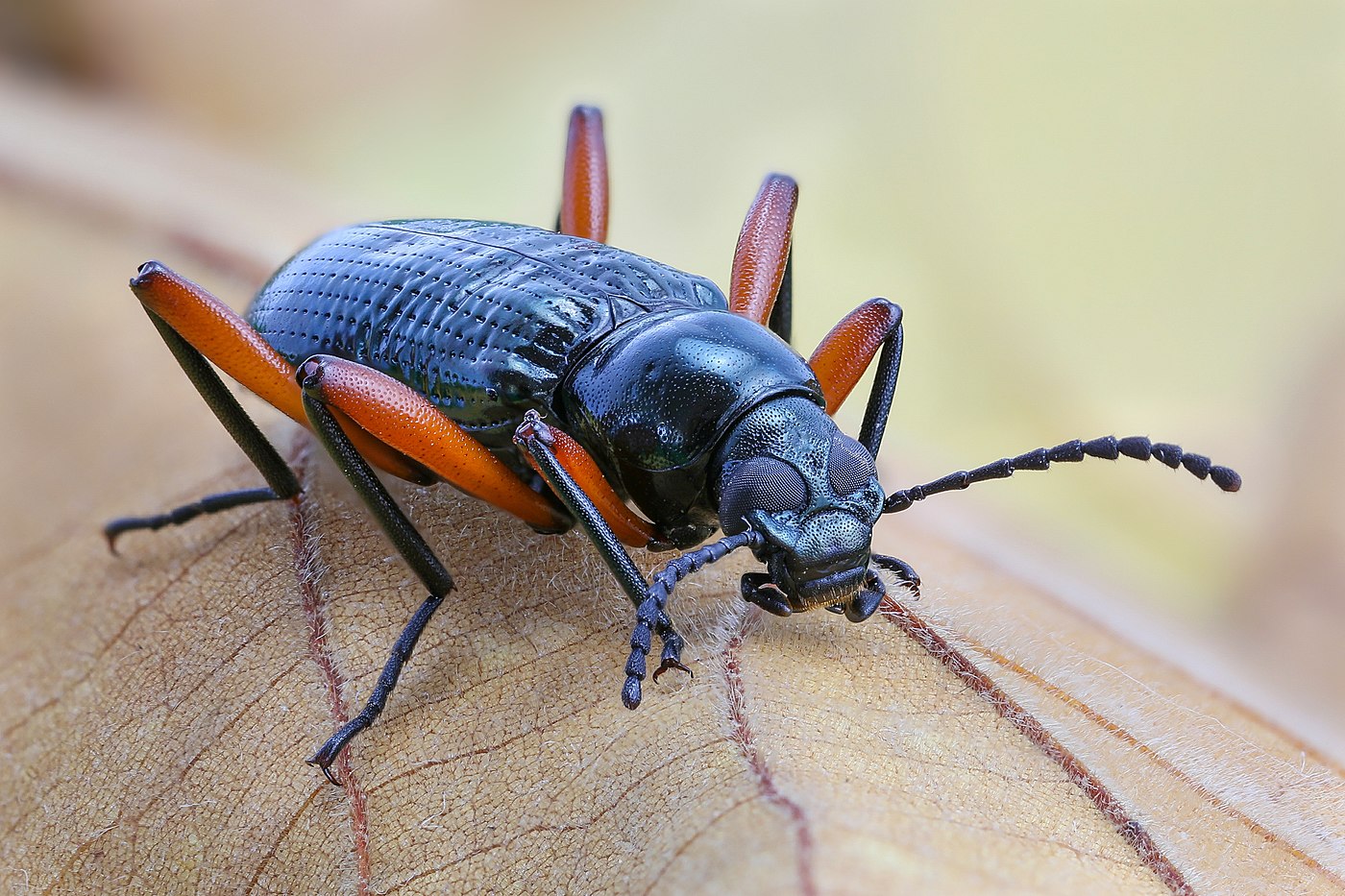
![]() Enlarge
Enlarge
Tenebrionidae Strongylium (Darkling beetle) on a leaf, in Don Det, Laos. Probably a Strongylium erythrocephalum (Fabricius, 1801). Macro view, Focus stacking from 16 pictures. This specimen measures approximately 15 mm (0.59 in) in length (legs excluded).
6 May 2018, 13:57
 This work was published in Futura.
This work was published in Futura.
 This picture is available on Wikimedia Commons with a free license CC BY-SA 4.0 (Attribution-ShareAlike 4.0 International) - © Basile Morin
This picture is available on Wikimedia Commons with a free license CC BY-SA 4.0 (Attribution-ShareAlike 4.0 International) - © Basile Morin
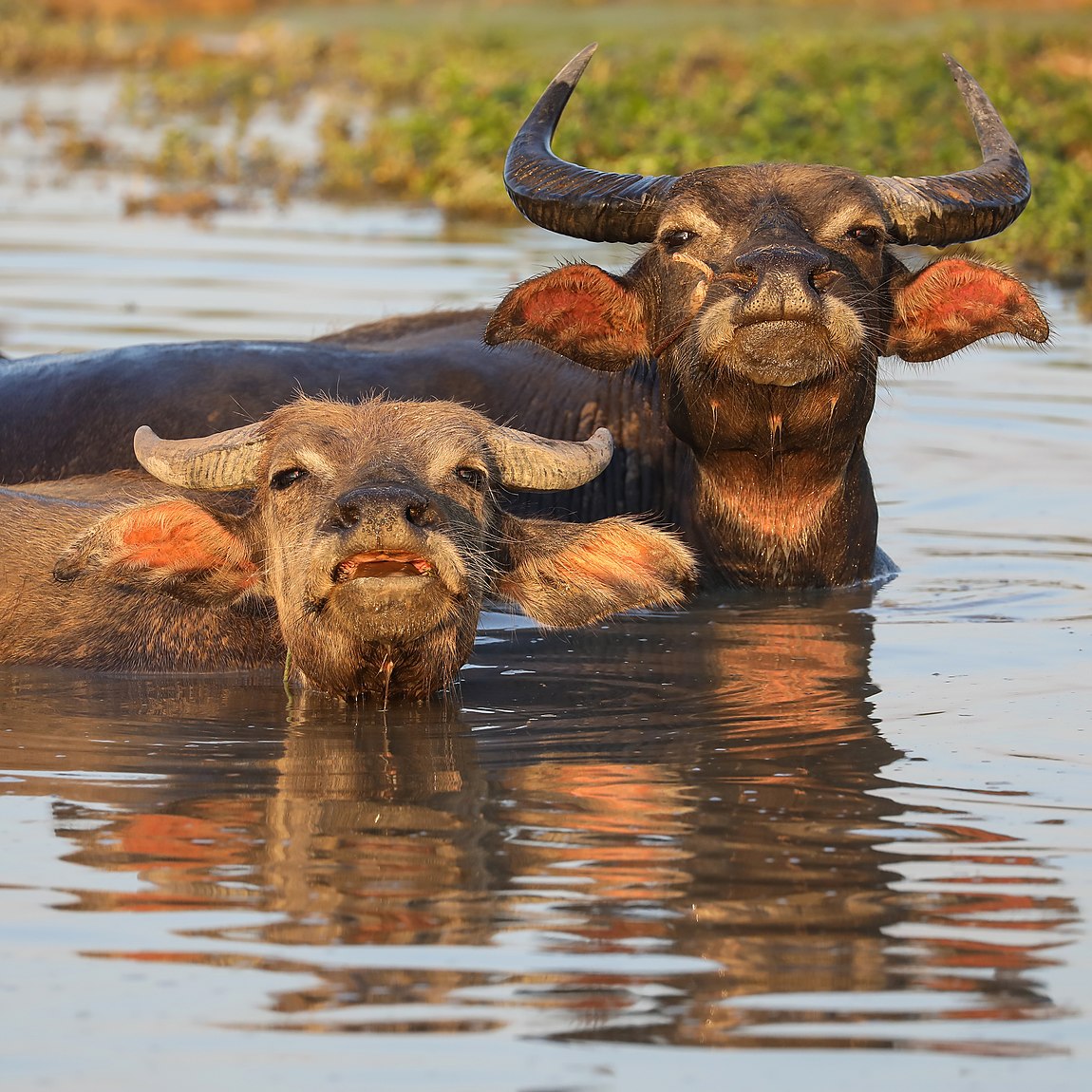
![]() Enlarge
Enlarge
Two Bubalus bubalis (water buffaloes) bathing at sunset in a pond of Don Det (Si Phan Don, Laos) rising high their snouts and looking at viewer. These buffaloes are often cooling themselves in the water (or in the mud), when the weather is hot. One of these domestic animals has a nose rope to facilitate its handling during the labour season, though here in May they are not yet attached, and thus free to move around the island. Focus stacking from 2 pictures.
15 May 2018, 17:45
 This picture has been published in the journal Washington University in St. Louis: "Facing the Beast - A personal journey in a landmark year", in 2020.
This picture has been published in the journal Washington University in St. Louis: "Facing the Beast - A personal journey in a landmark year", in 2020.
 This picture is available on Wikimedia Commons with a free license CC BY-SA 4.0 (Attribution-ShareAlike 4.0 International) - © Basile Morin
This picture is available on Wikimedia Commons with a free license CC BY-SA 4.0 (Attribution-ShareAlike 4.0 International) - © Basile Morin
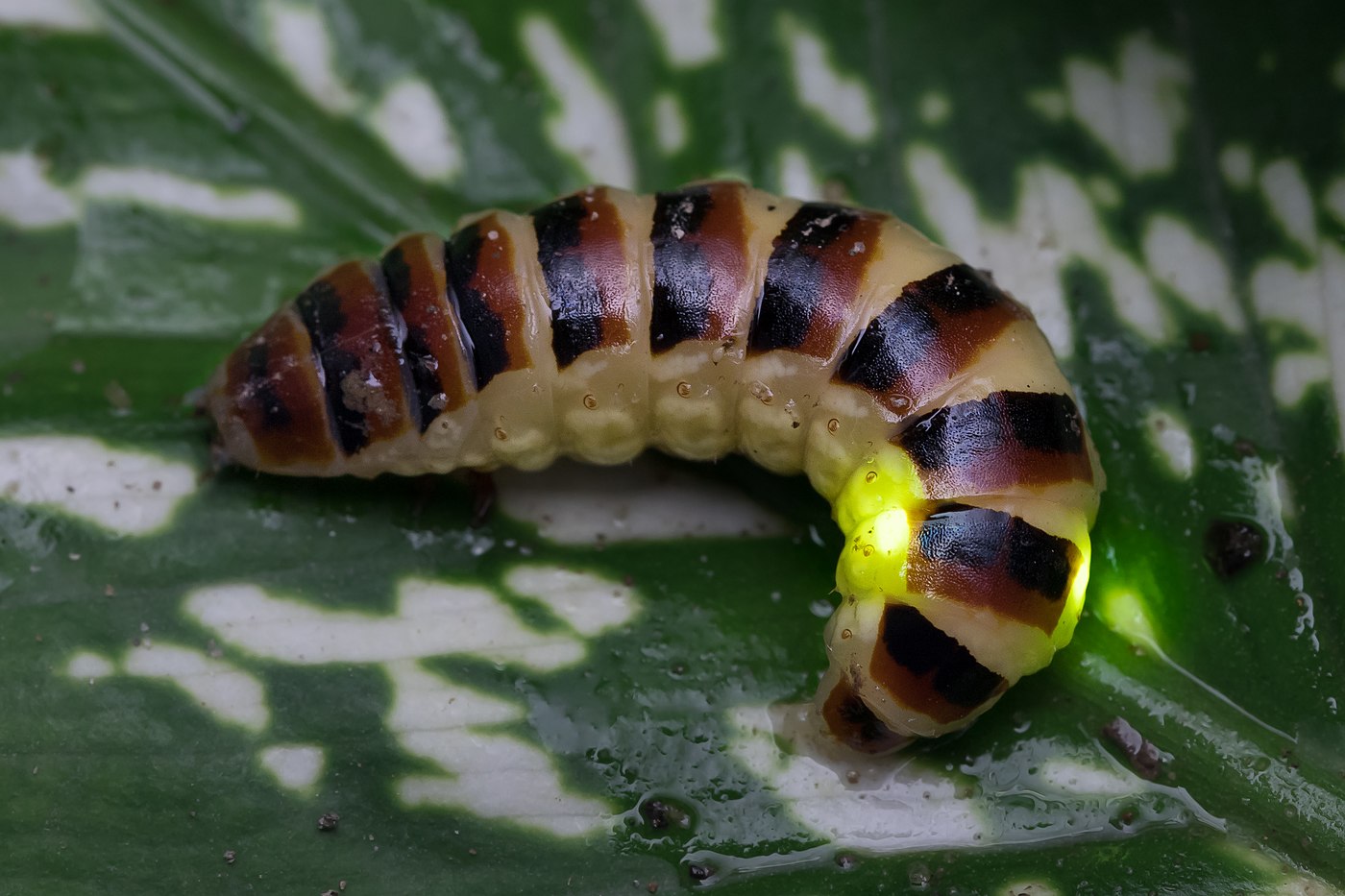
![]() Enlarge
Enlarge
Close-up view of a bioluminescent beetle Elateroidea (Lampyridae Ototretinae Stenocladius or Rhagophthalmidae), on a leaf. This specimen measures about 20 mm (0.79 in).
The species produces and emits light, via a chemical reaction during which chemical energy is converted into light energy. The principal chemical reaction in bioluminescence involves some light-emitting
molecule and an enzyme, generally called the luciferin and the luciferase, respectively. Oxidation of organic compounds induces photon emission. The intensity of this light can be perceived
by the human eye in a radius of 2 m (6.6 ft). This is a long-exposure photograph (1.3 s) made with a tripod and a macro lens, in the middle of the night (2 am). In conditions of ambient darkness,
the adjustment of the manual focus is difficult, and the camera settings (ISO and depth of field) should be done according to the mobility of the living organism, which may lead to motion blurs.
At any time, the insect can also decrease the intensity or even completely stop emitting its light (example here). A soft and diffuse auxiliary lamp has been brought to reveal the details of the animal.
Bioluminescent beetle species are in regression in the World because of the phenomenon of light pollution, insecticides and climate change. This specimen comes from the island of Don Det, Si Phan Don,
Laos, a wild area far from any major city.
2 September 2019, 01:54
 This photograph won the 1st prize of the Wiki Science Competition category Wildlife and nature from France.
This photograph won the 1st prize of the Wiki Science Competition category Wildlife and nature from France.
 This work was published in Science Times, in 2021.
This work was published in Science Times, in 2021.
 This picture is available on Wikimedia Commons with a free license CC BY-SA 4.0 (Attribution-ShareAlike 4.0 International) - © Basile Morin
This picture is available on Wikimedia Commons with a free license CC BY-SA 4.0 (Attribution-ShareAlike 4.0 International) - © Basile Morin
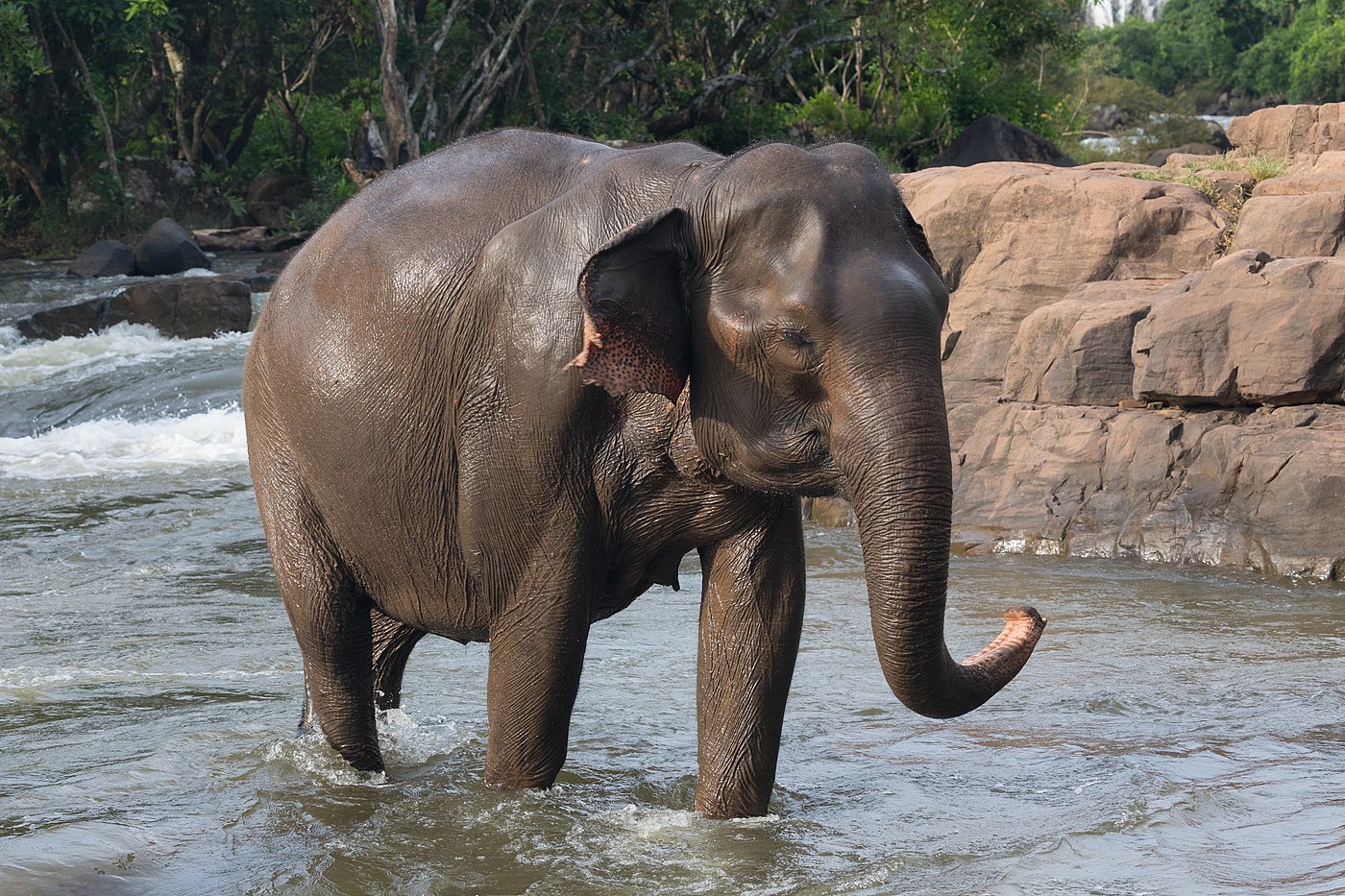
![]() Enlarge
Enlarge
Three-quarter view of an Asian elephant (Elephas maximus), female, walking in Tad Lo river at golden hour, Bolaven Plateau, Salavan Province, Laos.
23 June 2019, 16:39
 This work was published in Today in Conservation in 2020,
This work was published in Today in Conservation in 2020,
and in EuroJournalist in 2023.
 This picture is available on Wikimedia Commons with a free license CC BY-SA 4.0 (Attribution-ShareAlike 4.0 International) - © Basile Morin
This picture is available on Wikimedia Commons with a free license CC BY-SA 4.0 (Attribution-ShareAlike 4.0 International) - © Basile Morin
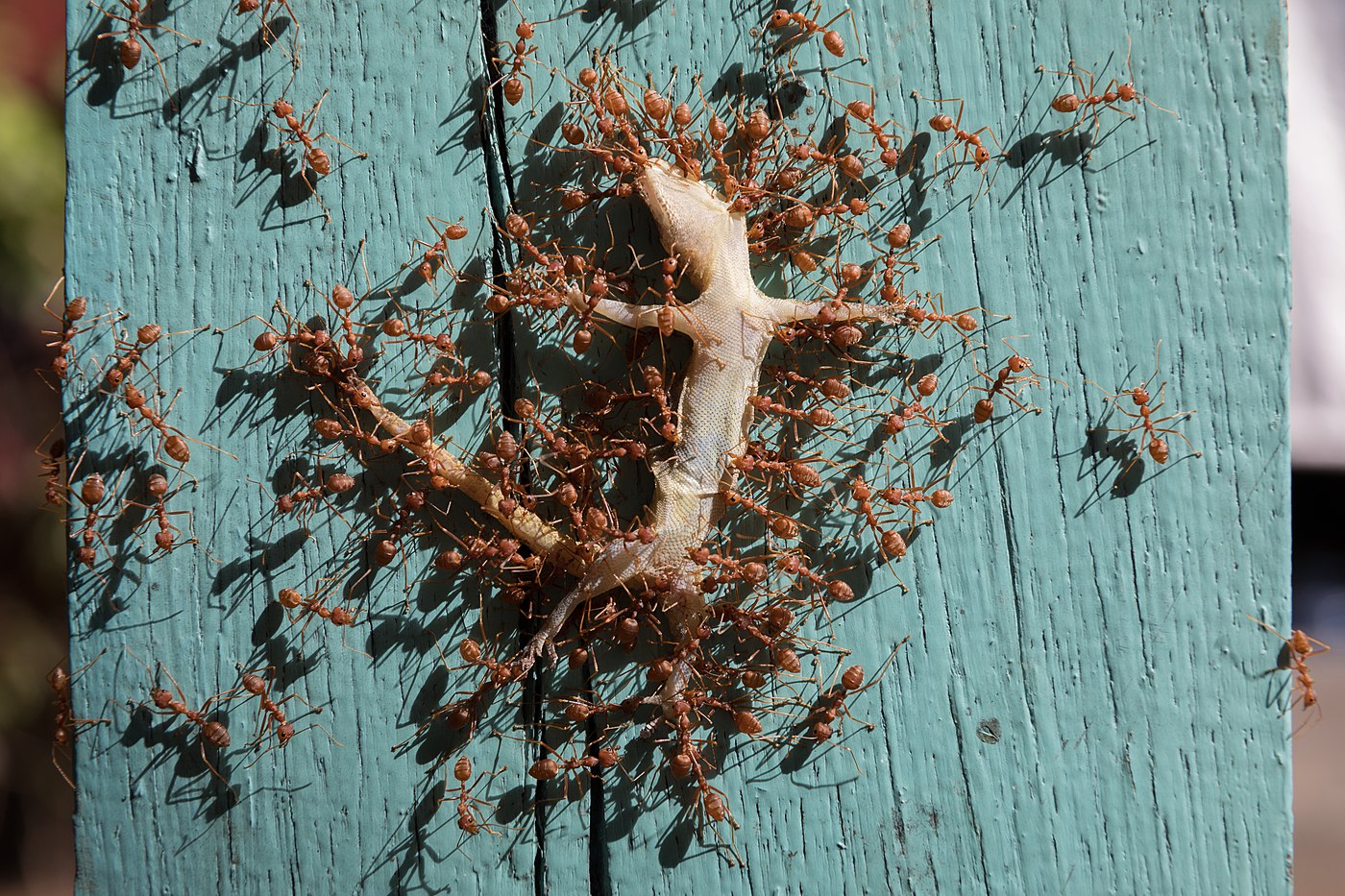
![]() Enlarge
Enlarge
Oecophylla smaragdina (red weaver ants) transporting a dead gecko, on a beam, in Laos.
13 October 2017, 14:24
 This video of the transportation won the
This video of the transportation won the  1st prize of the Wiki Science Competition category "Non-photographic media".
1st prize of the Wiki Science Competition category "Non-photographic media".
 This picture is available on Wikimedia Commons with a free license CC BY-SA 4.0 (Attribution-ShareAlike 4.0 International) - © Basile Morin
This picture is available on Wikimedia Commons with a free license CC BY-SA 4.0 (Attribution-ShareAlike 4.0 International) - © Basile Morin
_in_its_funnel_web_(2).jpg)
![]() Enlarge
Enlarge
Hippasa holmerae (Lawn wolf spider) in its funnel web, seen in Don Som (Si Phan Don), Laos.
6 January 2019, 16:57
 This picture has been published in Juneau Empire: "On the Trails: A wide world of webs", in 2022.
This picture has been published in Juneau Empire: "On the Trails: A wide world of webs", in 2022.
 This picture is available on Wikimedia Commons with a free license CC BY-SA 4.0 (Attribution-ShareAlike 4.0 International) - © Basile Morin
This picture is available on Wikimedia Commons with a free license CC BY-SA 4.0 (Attribution-ShareAlike 4.0 International) - © Basile Morin
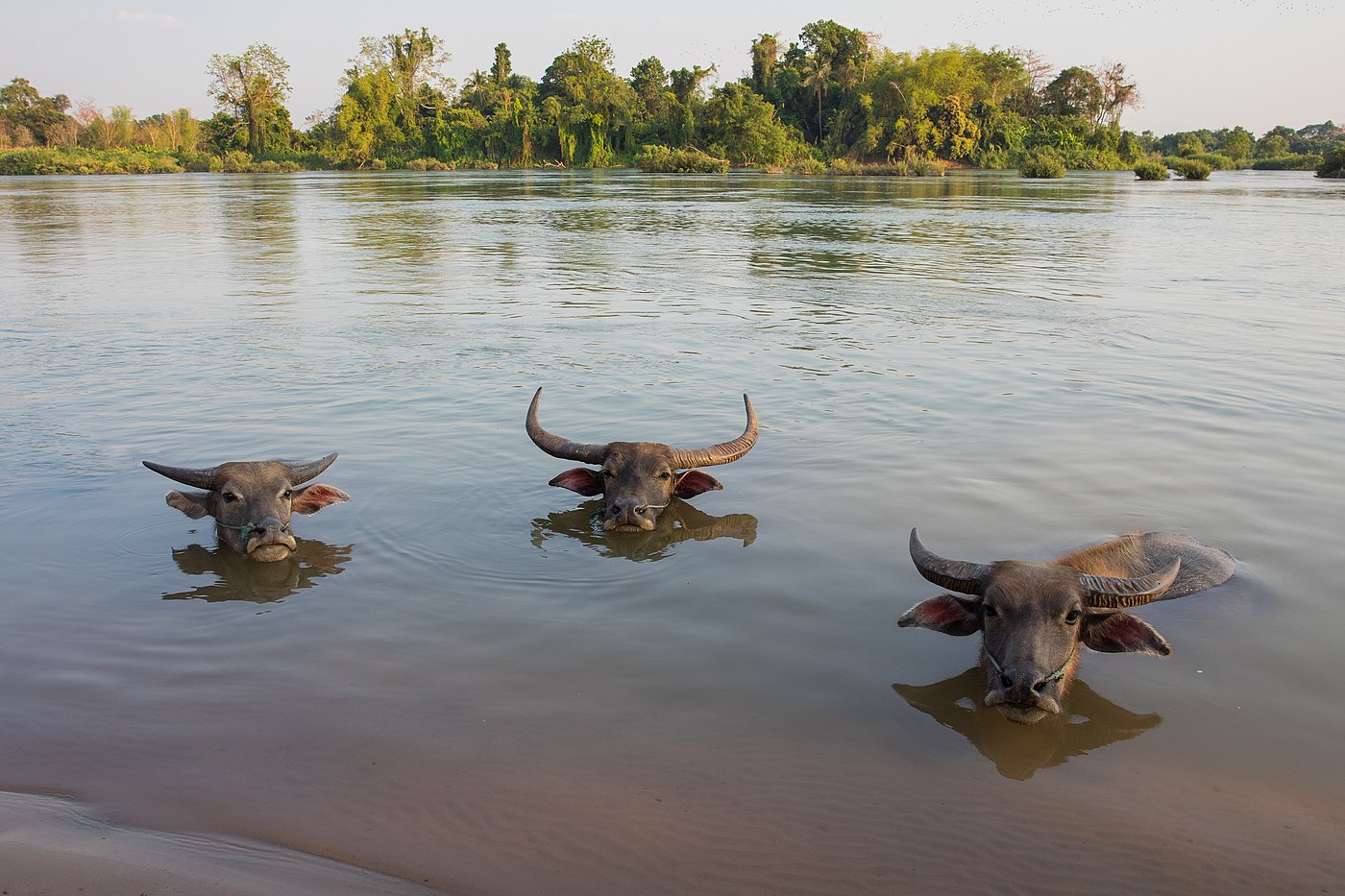
![]() Enlarge
Enlarge
Three Bubalus bubalis (water buffaloes) bathing in the Mekong in Don An (Si Phan Don, Laos) with their heads above water. These buffaloes are often cooling themselves in the water (or in the mud), when the weather is hot. These working animals have nose ropes to facilitate their handling during the labour season, though here in March they are not attached and are free to move where they want all around the island, sometimes even crossing the river.
18 March 2018, 16:51
 This picture is available on Wikimedia Commons with a free license CC BY-SA 4.0 (Attribution-ShareAlike 4.0 International) - © Basile Morin
This picture is available on Wikimedia Commons with a free license CC BY-SA 4.0 (Attribution-ShareAlike 4.0 International) - © Basile Morin
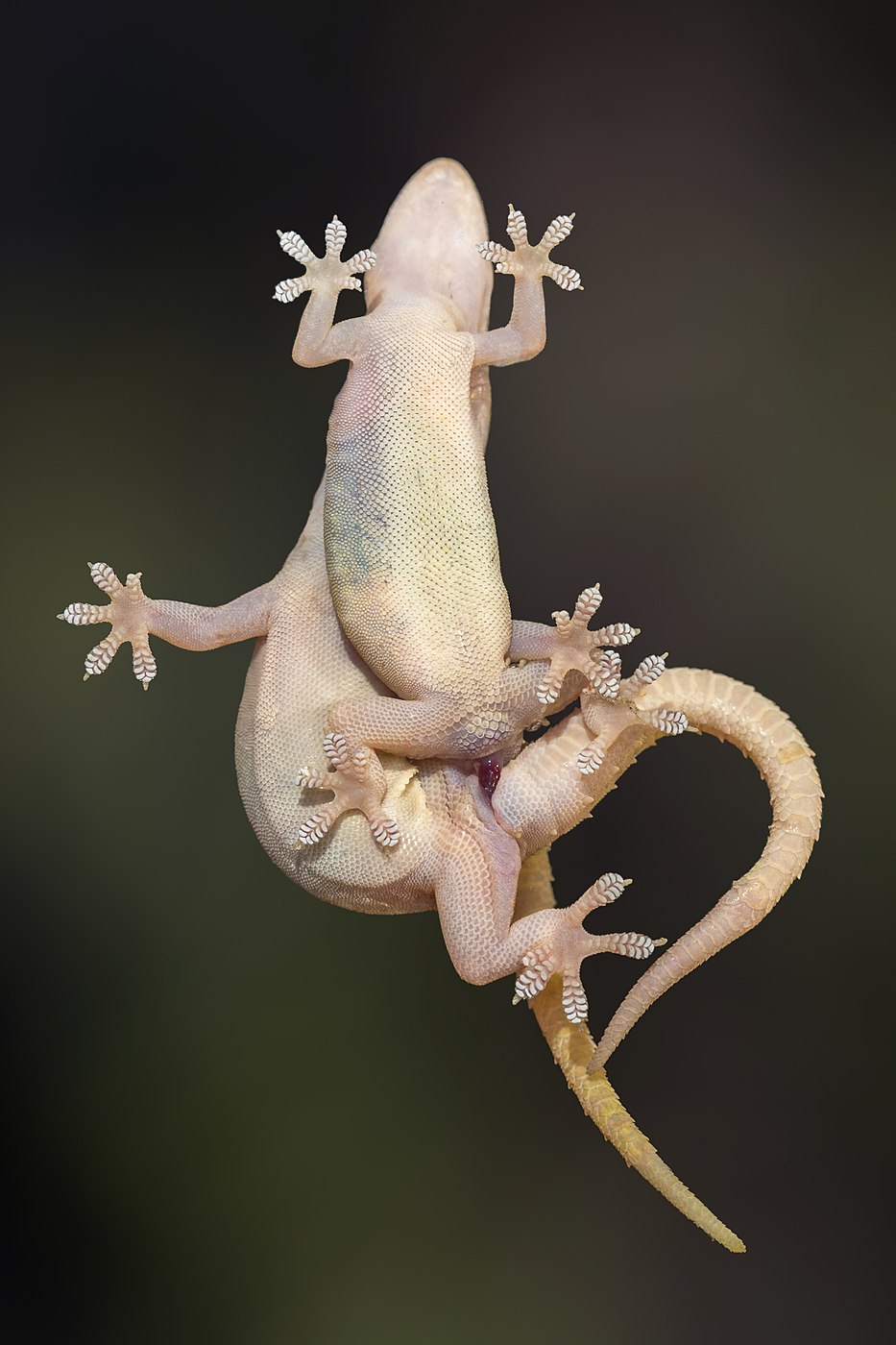
![]() Enlarge
Enlarge
Common House Geckos (Hemidactylus frenatus) mating. Ventral view with
hemipenis inserted in the cloaca.
This long-exposure photograph (2.5 s), taken in soft light (without flash) through a window with a macro
lens and a tripod, reveals many details, like the sexual organs and the adhesive lamellae with setae under the feet (allowing traction of the reptile on smooth surfaces). All male squamates have a pair
of intromittent organs called hemipenes, inside a sheath in the inner portion of the tail (sometimes producing a bulge), usually held inverted within the body, and everted for reproduction via erectile tissue.
Only one of these hemipenis is used during the reproductive intercourse. Reciprocally, females own two hemiclitores. Single organ in the form of a canal, closed by the anal sphincter, the genital opening of female
reptiles (the cloaca) allows either the exit of eggs, the evacuation of urine and feces, and reproduction. To adhere and cling to the surface of vertical smooth materials like glass, the geckos have lamellae under
their feet, with a lot of setae, kind of bristle- or hair-like structures creating interactions with the support. The total of the micro-forces of each microscopic seta offers a very powerful adhesion. Non-captive,
this couple through the glass is totally undomesticated. The geckos of this region of Laos (island of Don Det, Si Phan Don) usually appreciate houses, especially the illuminated transparent walls, where they can
easily hunt insects attracted by light. Fearful by nature, they tend to flee the proximity of humans, and their visible mating thus occurs in an exceptional way. The sexual activity is relatively quick, and
frequently the female dodges the male which, not very gallantly, bites the neck to immobilize her. In these wild conditions, the visual observation by physical rapprochement is perilous, the installation of
a tripod timed, the adjustment of the manual focus delicate given the low light, and the camera settings complex because of the frequent jolts during the sexual act, which may lead to motion blurs. If fertilisation
was successful, then the oviparous female will spawn its eggs about four weeks later.
12 August 2019, 19:05
 This picture is available on Wikimedia Commons with a free license CC BY-SA 4.0 (Attribution-ShareAlike 4.0 International) - © Basile Morin
This picture is available on Wikimedia Commons with a free license CC BY-SA 4.0 (Attribution-ShareAlike 4.0 International) - © Basile Morin
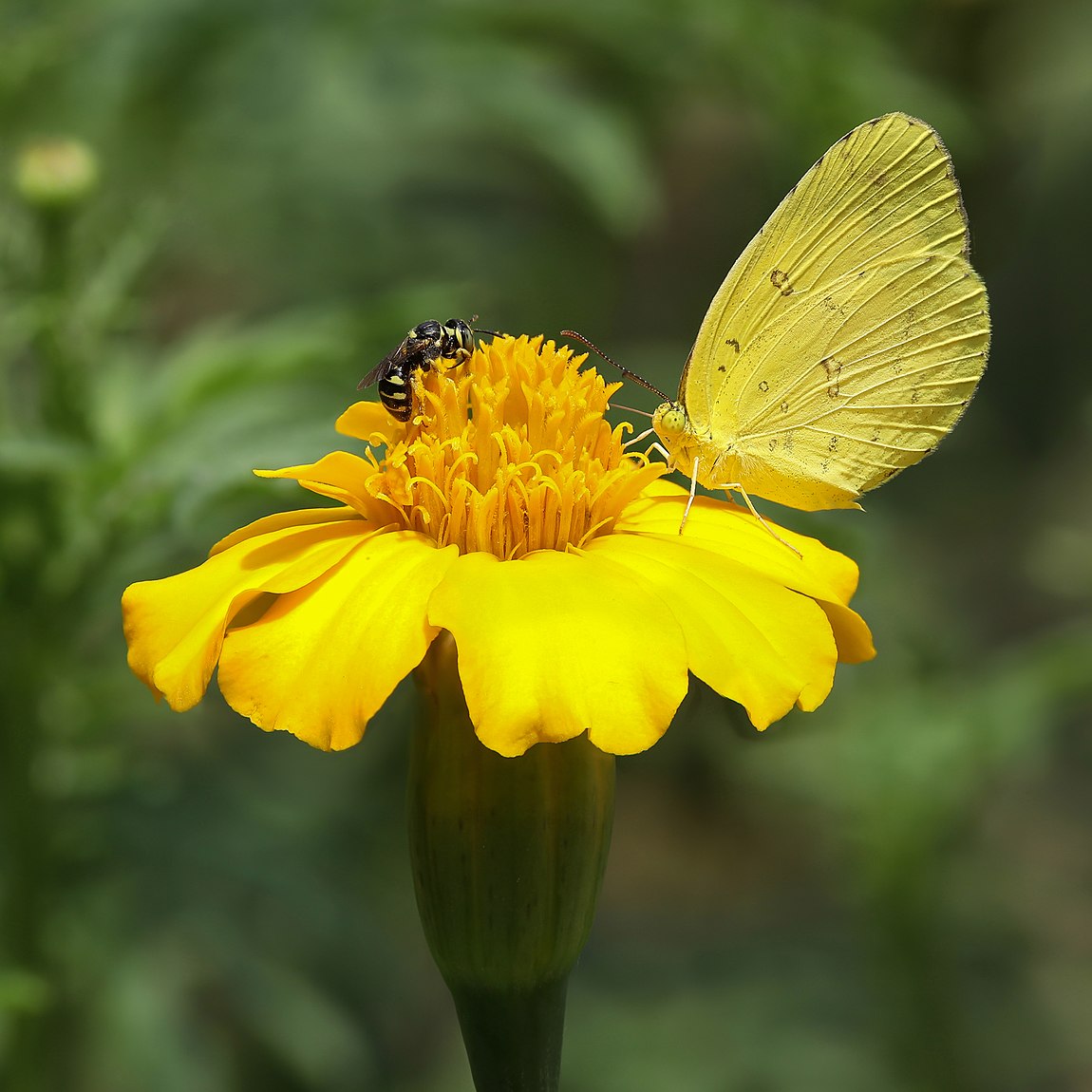
![]() Enlarge
Enlarge
Vespidae (wasp) and Eurema blanda (three-spot grass yellow) butterfly on a tagetes lucida (marigold), in Laos. Focus stacking picture from 7 photos. Peak of the dry season.
18 April 2018, 10:23
 This picture is available on Wikimedia Commons with a free license CC BY-SA 4.0 (Attribution-ShareAlike 4.0 International) - © Basile Morin
This picture is available on Wikimedia Commons with a free license CC BY-SA 4.0 (Attribution-ShareAlike 4.0 International) - © Basile Morin
_in_flight,_side_view.jpg)
![]() Enlarge
Enlarge
Pantala flavescens (globe skimmer, globe wanderer or wandering glider) male, in flight, in a paddy field, in Don Det, Si Phan Don, Laos. Side view.
16 August 2017, 17:02
 This picture has been published in Mongabay: " High-flying dragons: how the globe skimmer migrates across the Indian Ocean", in 2021.
This picture has been published in Mongabay: " High-flying dragons: how the globe skimmer migrates across the Indian Ocean", in 2021.
and in Scroll.in: "Tracing the flight of the globe skimmer dragonfly across the Indian Ocean".
 This picture is available on Wikimedia Commons with a free license CC BY-SA 4.0 (Attribution-ShareAlike 4.0 International) - © Basile Morin
This picture is available on Wikimedia Commons with a free license CC BY-SA 4.0 (Attribution-ShareAlike 4.0 International) - © Basile Morin
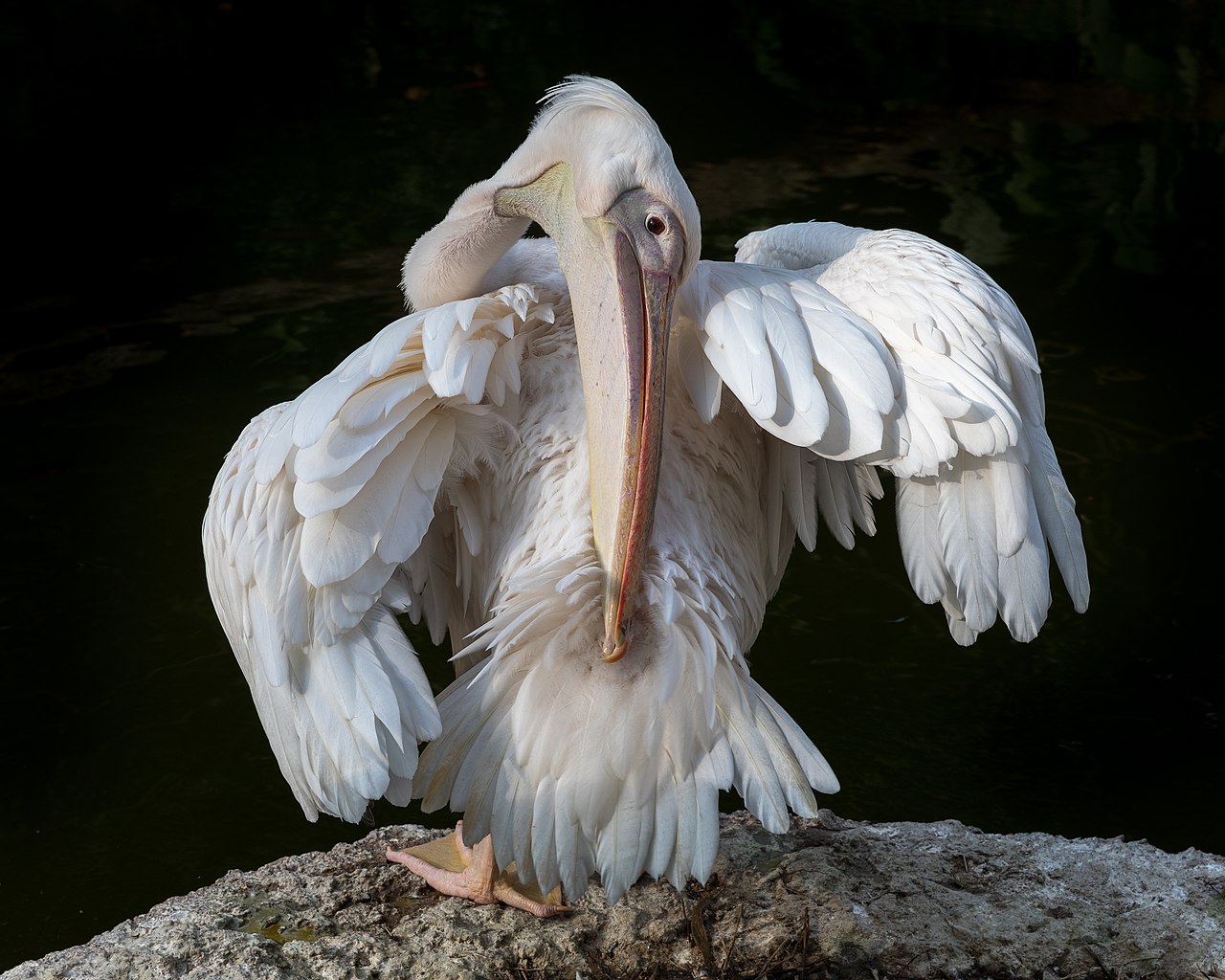
![]() Enlarge
Enlarge
Pelecanus onocrotalus (Great white pelican) cleaning the feathers of its back with its long beak by writhing the neck, at sunset, in Singapore Zoo.
9 June 2018, 16:16
 This picture is available on Wikimedia Commons with a free license CC BY-SA 4.0 (Attribution-ShareAlike 4.0 International) - © Basile Morin
This picture is available on Wikimedia Commons with a free license CC BY-SA 4.0 (Attribution-ShareAlike 4.0 International) - © Basile Morin
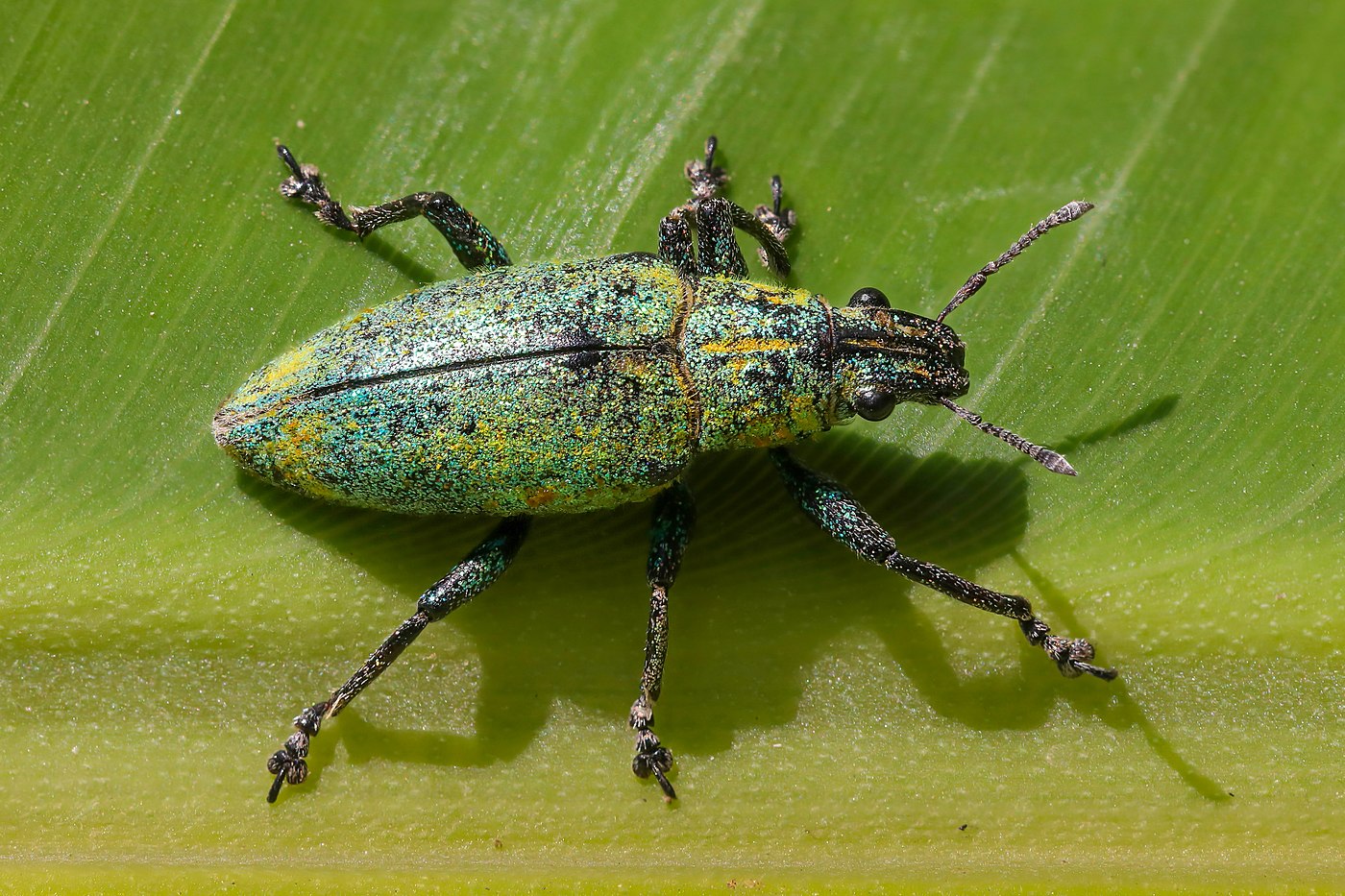
![]() Enlarge
Enlarge
Brilliant metallic green Hypomeces squamosus (weevil) on a green leaf, in Don Det, Si Phan Don, Laos. The insect measures about 12 mm long. This picture is a digital montage based on 5 different photographs (freehand camera), using the Focus stacking technique (Helicon focus software).
15 April 2018, 09:47
 This picture is available on Wikimedia Commons with a free license CC BY-SA 4.0 (Attribution-ShareAlike 4.0 International) - © Basile Morin
This picture is available on Wikimedia Commons with a free license CC BY-SA 4.0 (Attribution-ShareAlike 4.0 International) - © Basile Morin
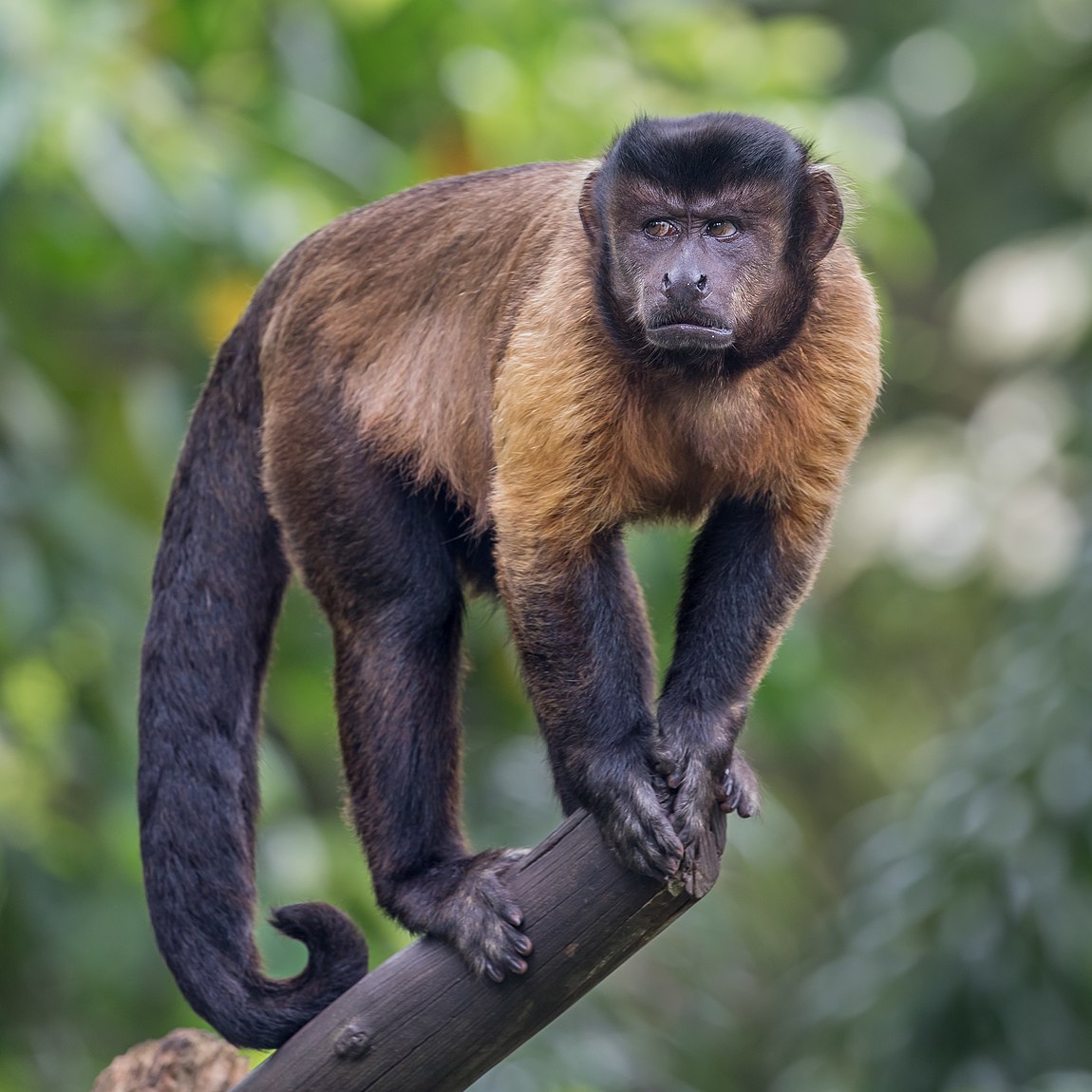
![]() Enlarge
Enlarge
Sapajus apella (Tufted capuchin) starring at the horizon, on a branch, in Singapore.
9 June 2018, 11:19
 This picture has been published in Vesmir : "Navonme jim klece", in 2022.
This picture has been published in Vesmir : "Navonme jim klece", in 2022.
 This picture is available on Wikimedia Commons with a free license CC BY-SA 4.0 (Attribution-ShareAlike 4.0 International) - © Basile Morin
This picture is available on Wikimedia Commons with a free license CC BY-SA 4.0 (Attribution-ShareAlike 4.0 International) - © Basile Morin

![]() Enlarge
Enlarge
Toy Poodle wearing clothes in Ueno Park, Tokyo, Japan. Kawaii ("lovable", "cute", or "adorable") is the culture of cuteness in Japan.
8 June 2019, 06:18
 This picture is available on Wikimedia Commons with a free license CC BY-SA 4.0 (Attribution-ShareAlike 4.0 International) - © Basile Morin
This picture is available on Wikimedia Commons with a free license CC BY-SA 4.0 (Attribution-ShareAlike 4.0 International) - © Basile Morin
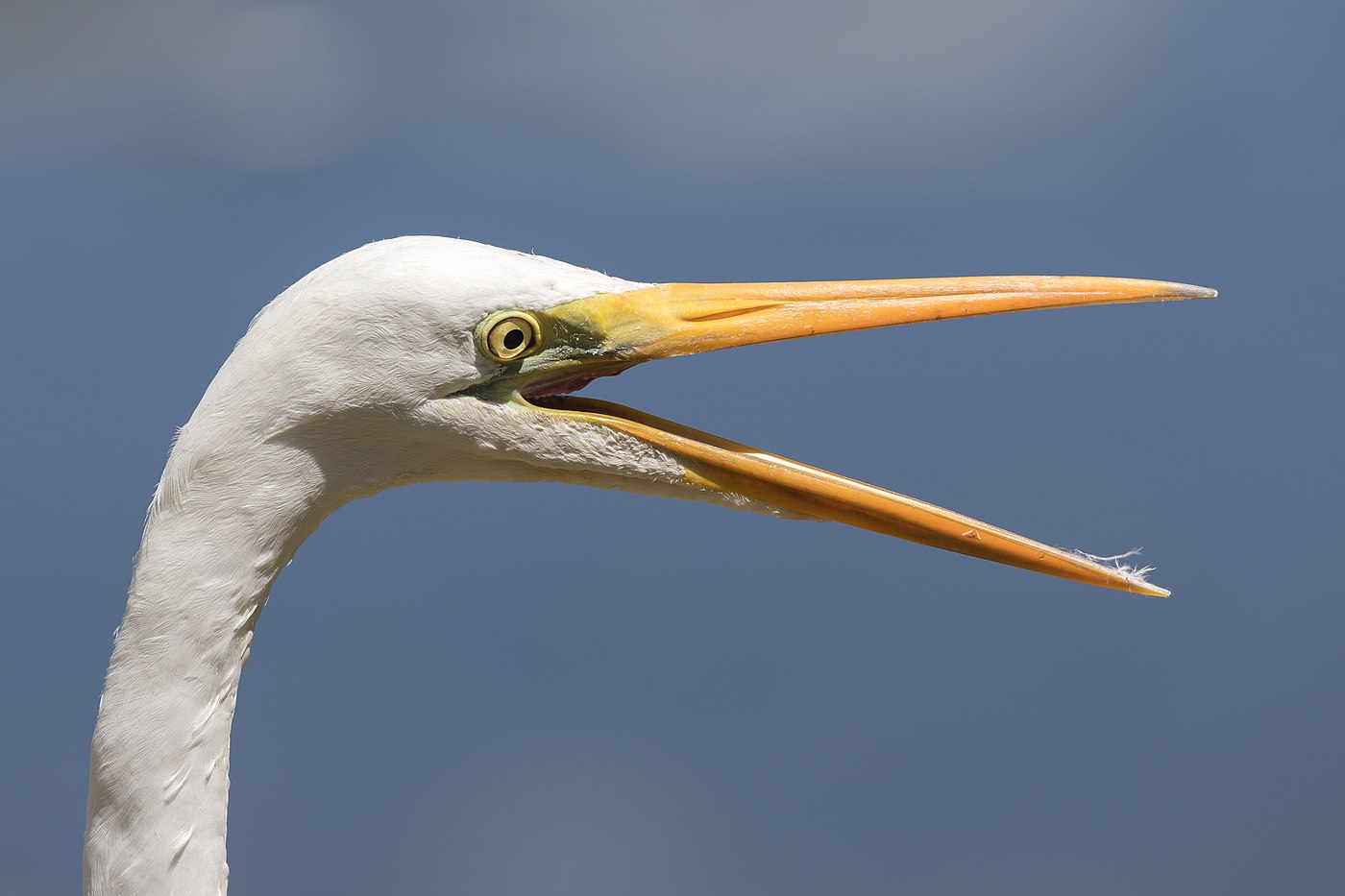
![]() Enlarge
Enlarge
Close-up view of the head of an Eastern great egret (Ardea alba modesta) with open beak, in Shinjuku Gyoen National Garden, Tokyo, Japan.
16 June 2019, 13:26
 This picture is available on Wikimedia Commons with a free license CC BY-SA 4.0 (Attribution-ShareAlike 4.0 International) - © Basile Morin
This picture is available on Wikimedia Commons with a free license CC BY-SA 4.0 (Attribution-ShareAlike 4.0 International) - © Basile Morin
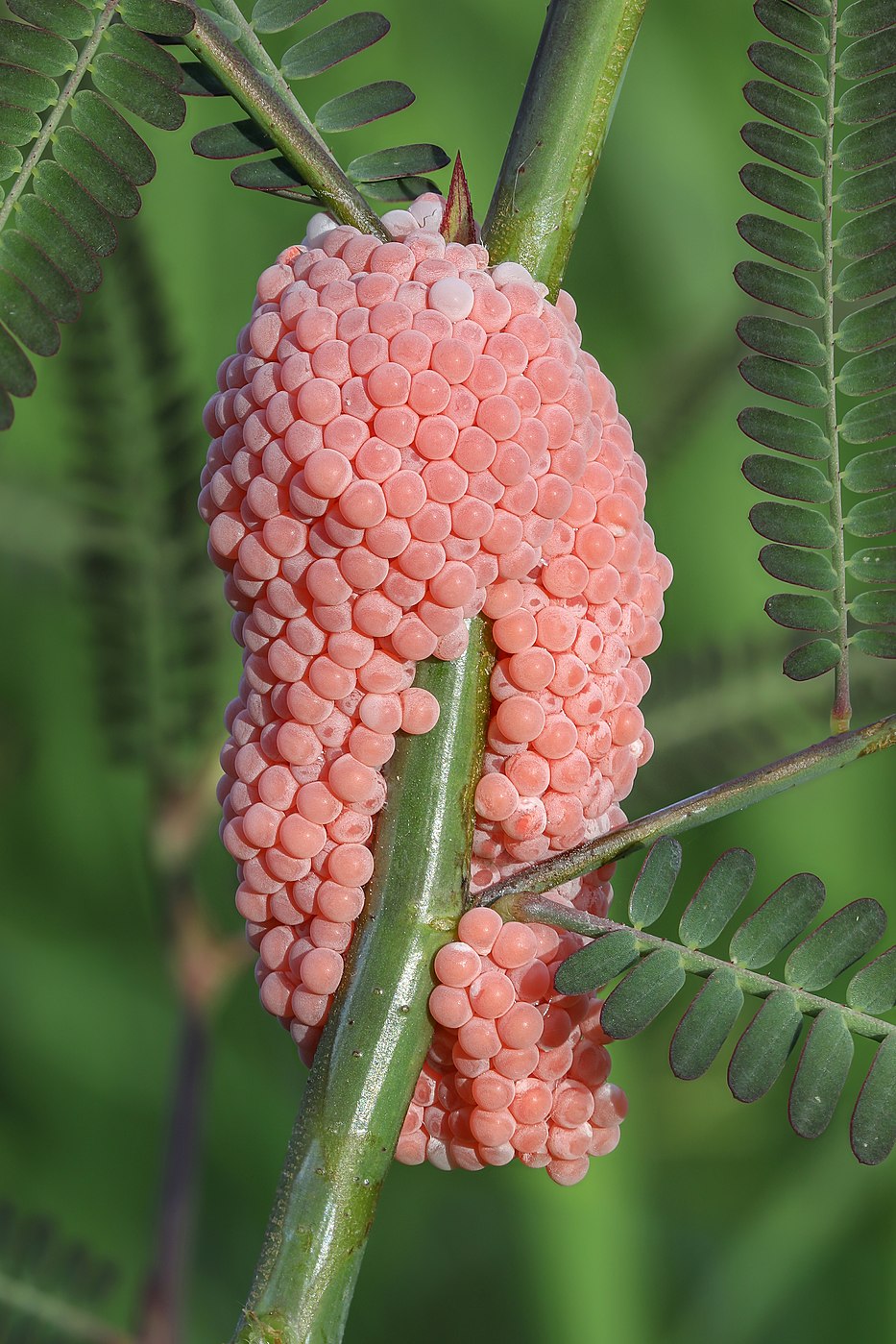
![]() Enlarge
Enlarge
Golden apple snail pink eggs on a stem, in a rice field at golden hour, in Don Det, Si Phan Don, Laos. Focus stacking from 9 pictures.
1 September 2019, 17:01
 This picture is available on Wikimedia Commons with a free license CC BY-SA 4.0 (Attribution-ShareAlike 4.0 International) - © Basile Morin
This picture is available on Wikimedia Commons with a free license CC BY-SA 4.0 (Attribution-ShareAlike 4.0 International) - © Basile Morin
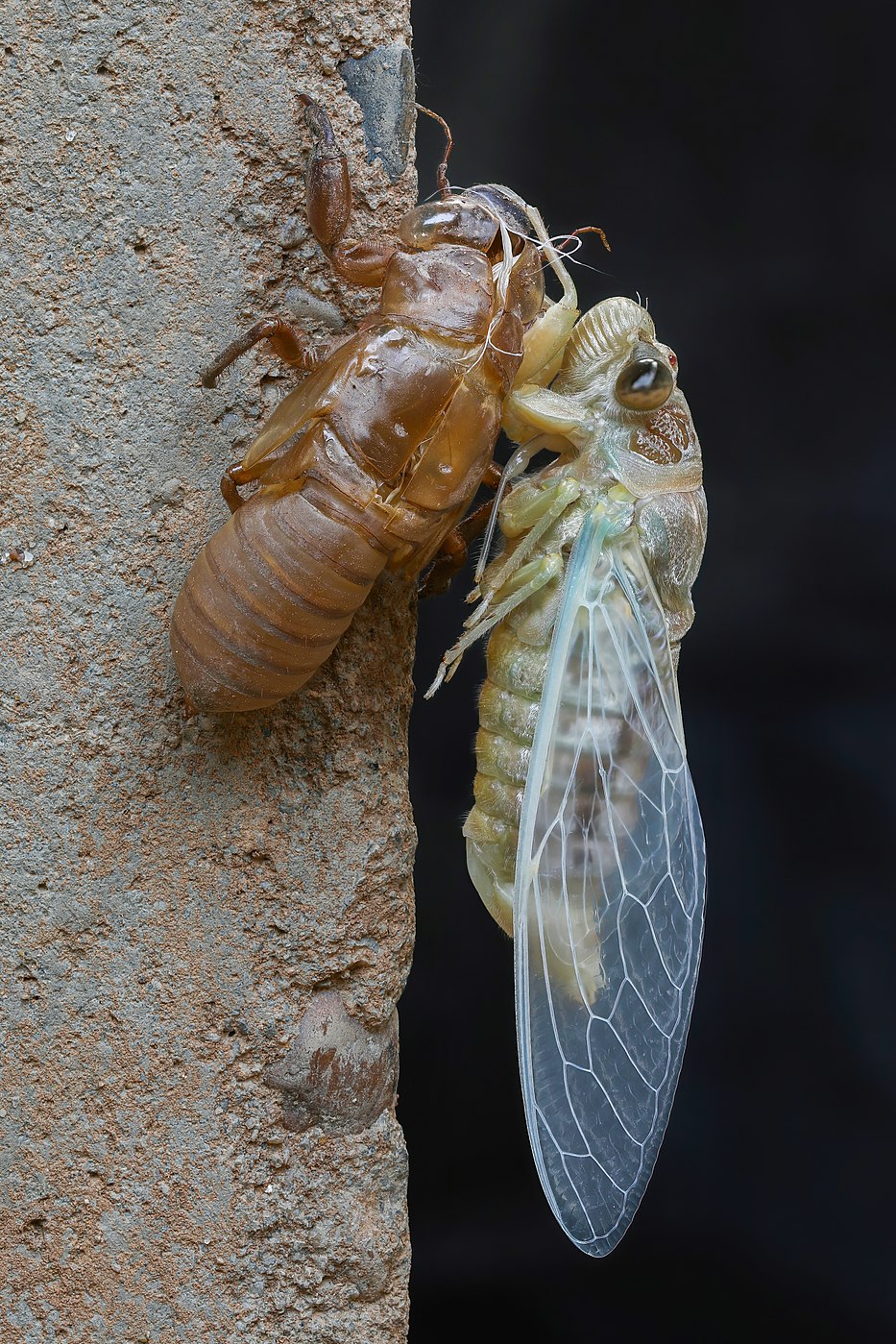
![]() Enlarge
Enlarge
Cicadidae Dundubia (cicada) standing next to its exuvia, immediately after moulting, side view. Seen on the island of Don Det, Si Phan Don, Laos.
Focus stacking from 8 pictures. The body (without wings) measures approximately 35 mm (1.4 in). The species could be Dundubia jacoona (Distant, 1888) or Dundubia oopaga (Distant, 1881), difficult identification since the colors are not yet definitive.
27 March 2020, 06:20
 This picture is available on Wikimedia Commons with a free license CC BY-SA 4.0 (Attribution-ShareAlike 4.0 International) - © Basile Morin
This picture is available on Wikimedia Commons with a free license CC BY-SA 4.0 (Attribution-ShareAlike 4.0 International) - © Basile Morin
 Another version of this picture was published in the book The Skeletal and Muscular Systems: "Bones and other Skeletal Components" (page 6), in 2021.
Another version of this picture was published in the book The Skeletal and Muscular Systems: "Bones and other Skeletal Components" (page 6), in 2021.
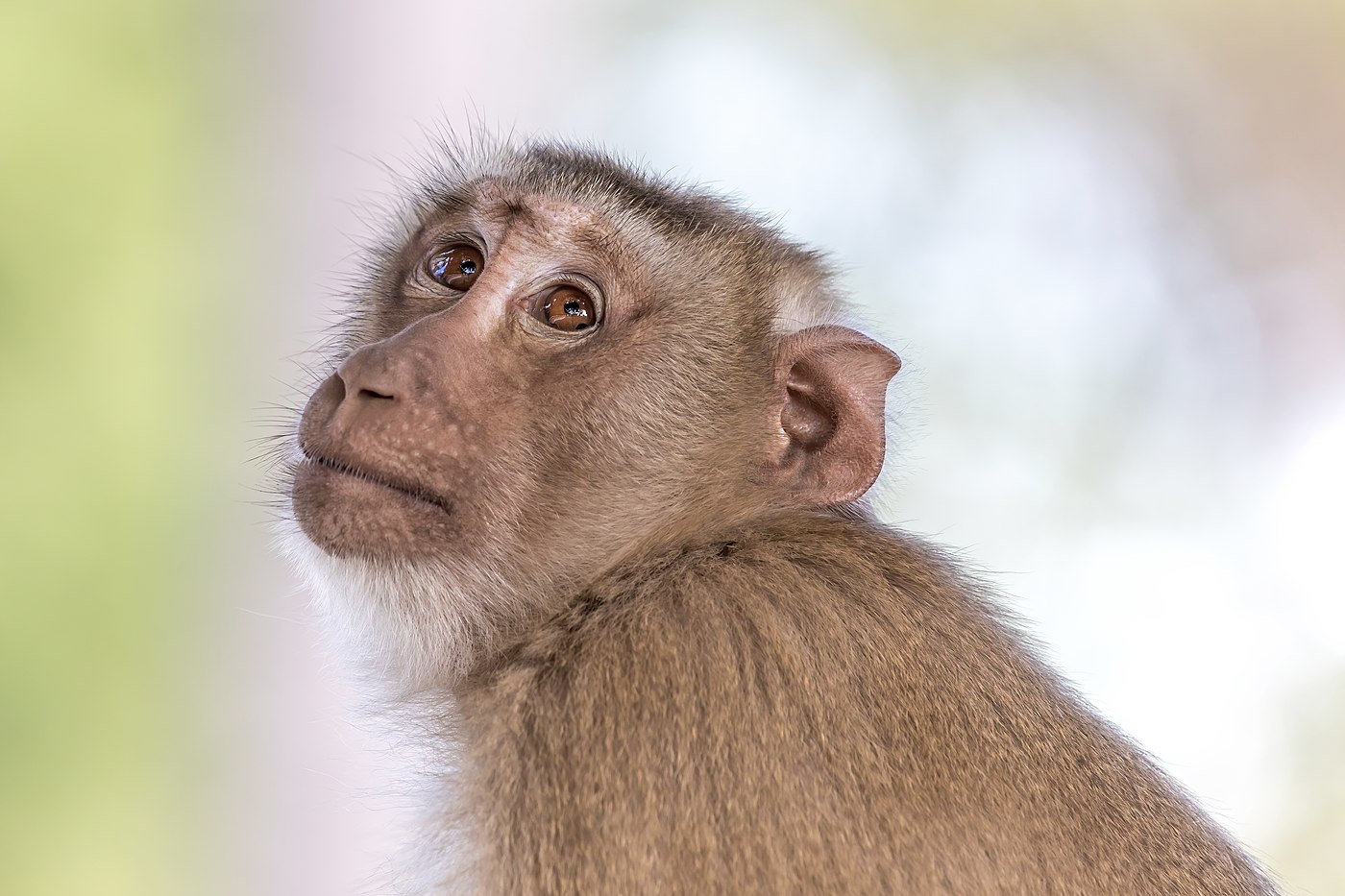
![]() Enlarge
Enlarge
Macaca fascicularis (crab-eating macaque) looking up to the sky with a dreamy facial expression (anthropomorphism?). Side view and contre-jour portrait with smooth bokeh, at the temple of Don Som, Si Phan Don, Laos.
6 December 2018, 15:11
 This picture has been published in Usbek & Rica: "Covid-19 : la décisive (et très discrète) contribution des singes de laboratoire", in 2021.
This picture has been published in Usbek & Rica: "Covid-19 : la décisive (et très discrète) contribution des singes de laboratoire", in 2021.
 This picture is available on Wikimedia Commons with a free license CC BY-SA 4.0 (Attribution-ShareAlike 4.0 International) - © Basile Morin
This picture is available on Wikimedia Commons with a free license CC BY-SA 4.0 (Attribution-ShareAlike 4.0 International) - © Basile Morin
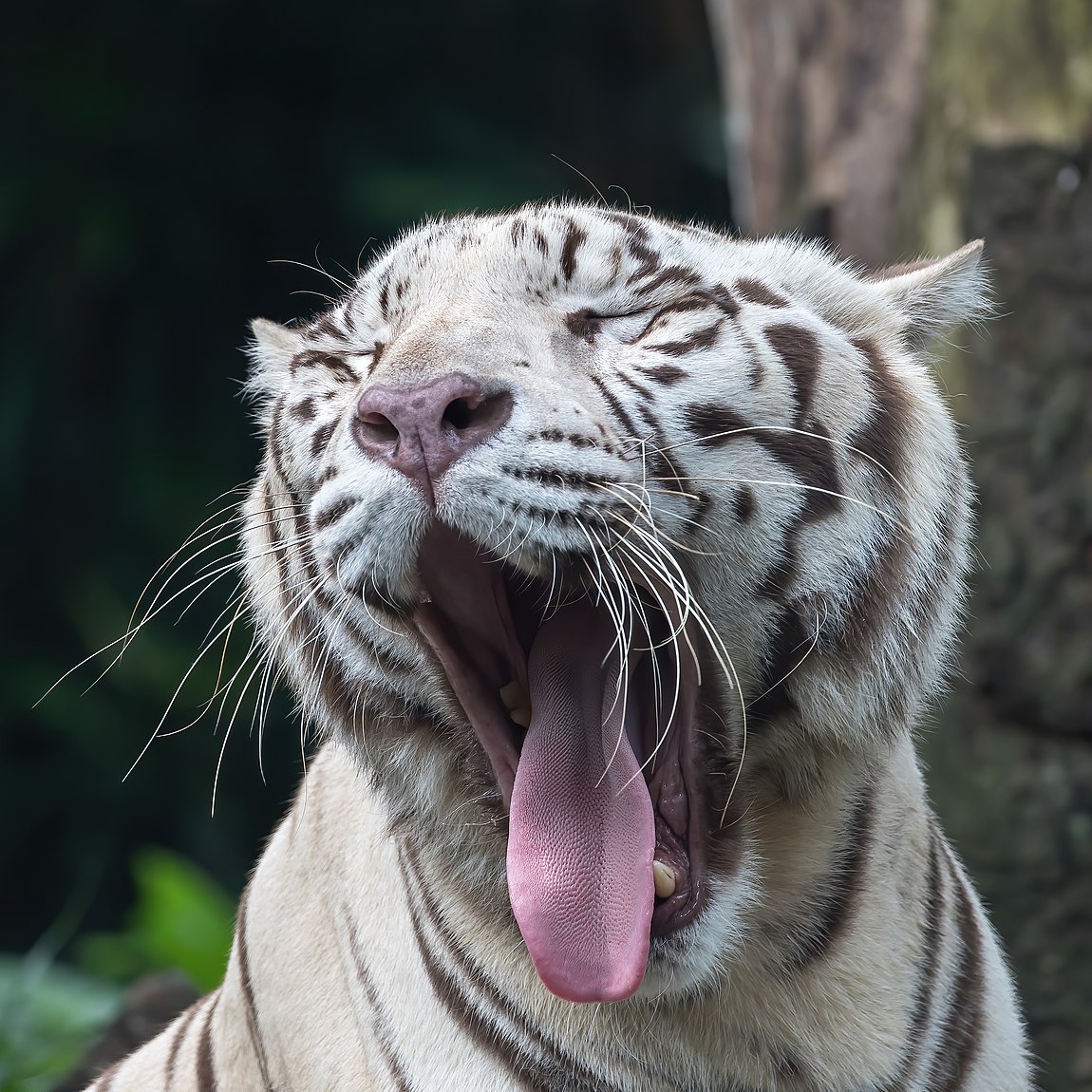
![]() Enlarge
Enlarge
Close-up view of the head of a white tiger (Bengal tiger species), yawning with the tongue out, at Singapore Zoo.
9 June 2018, 10:18
 This photograph was a finalist in Picture of the Year 2020 international challenge on Wikimedia Commons.
This photograph was a finalist in Picture of the Year 2020 international challenge on Wikimedia Commons.
 This picture is available on Wikimedia Commons with a free license CC BY-SA 4.0 (Attribution-ShareAlike 4.0 International) - © Basile Morin
This picture is available on Wikimedia Commons with a free license CC BY-SA 4.0 (Attribution-ShareAlike 4.0 International) - © Basile Morin
 See my « quality images » on Wikimedia Commons
shared with a free license CC BY-SA 4.0 (Attribution-ShareAlike 4.0 International) on this subject: Animals.
See my « quality images » on Wikimedia Commons
shared with a free license CC BY-SA 4.0 (Attribution-ShareAlike 4.0 International) on this subject: Animals.
© Basile Morin | contact : basile.morin@gmail.com